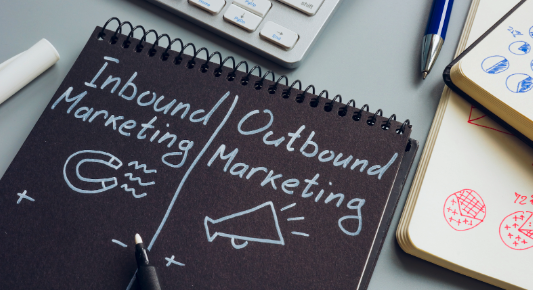In the world of marketing, two approaches remain as dominant strategies, so today we will discuss the difference between inbound and outbound marketing. Each approach has its unique strengths, and understanding the differences between them is crucial for businesses looking to execute an effective marketing strategy. In this blog post, we’ll take a closer look into the nuances of inbound and outbound marketing to help you decide which strategy aligns best with your goals.
What is Inbound Marketing?
Inbound marketing is a customer-centric approach that aims to attract and engage potential customers through relevant and valuable content. Instead of reaching out to a broad audience, inbound marketing focuses on creating content that speaks to the specific needs and interests of your target audience. Inbound marketing is a great way for you to show how your product or service can solve a particular problem for your target audience. Key elements of inbound marketing include:
Content Creation: Inbound marketing relies heavily on content creation including blog posts, eBooks, videos, podcasts, and social media content that provide value and information to your audience. Content creation does not need to be a burden, you can rely on your marketing collateral to create new content.
SEO (Search Engine Optimization): Optimizing your content for search engines helps your target audience discover your content organically when they search for relevant topics or keywords. SEO cannot be a set it and forget it strategy, it is something that you need to be consistently monitoring. Using a tool like MOZ can help you be successful.
Social Media Marketing: Engaging with your audience on social media platforms by sharing valuable content and fostering relationships is key to inbound marketing. Social media is an opportunity to be a part of relevant industry conversations, and engage with potential prospects. Utilizing your team and having them engage, comment and share on social media, especially LinkedIn is a great way to bring in potential clients.
Email Marketing: Building and nurturing relationships with leads through email campaigns is a great way to build your inbound marketing efforts. Having an email schedule is key to ensuring you are connecting with your prospects on a regular basis.
Now that we have covered inbound marketing, let’s explore outbound marketing and where the differences exist.
What is Outbound Marketing?
Outbound marketing, is a more traditional approach that involves pushing your message out to a wider audience, often through paid advertising channels. Outbound marketing requires more heavy lifting as it is a marketer-initiated strategy that includes tactics such as:
Paid Ads: Running commercials to reach a broad audience on channels such as television, radio and digital ads such as Google ads. With paid ads you are putting a budget behind your initiatives and targeting your audience with a message that you think will resonate with them and get them into your sales funnel.
Print Advertising: Placing ads in newspapers, magazines, and other print publications that you think are relevant to your audience.
Trade Shows and Events: Participating in industry-specific events to promote products or services is a great way to connect with potential customers. When you attend a trade show, you are putting your business directly in front of an audience that is looking for a specific solution, so the chances of bringing in customers are higher.
Now that we have explored the key parts of both inbound and outbound marketing, it is important to understand the difference between inbound and outbound marketing so you understand what tactics will work best for your business.
Key Differences
Audience Engagement: Inbound marketing focuses on attracting and engaging an audience that is already interested in your industry or product, while outbound marketing seeks to capture the attention of a broader audience.
Cost: Inbound marketing can be cost-effective in the long run, as it relies on creating valuable and existing content that continues to attract leads over time. Outbound marketing often requires a higher initial investment in advertising.
Customer Relationships: Inbound marketing emphasizes building meaningful relationships with potential customers over time, while outbound marketing is often transactional and the time spent is shorter.
Measurability: Inbound marketing campaigns are highly measurable, allowing you to track the performance of your content and adjust strategies as needed. Outbound marketing’s effectiveness can be harder to measure accurately, since you a are hitting a wider and broader audience with wide spread tactics.
Ultimately, the choice between inbound and outbound marketing depends on your business goals, target audience, budget and needs. Many successful businesses use a combination of both approaches to maximize their reach and impact, but understanding your audience and what they need is key to finding the right balance between the two tactics and how they fit into your overall marketing strategy.
Now that you know the difference between inbound and outbound marketing, the choice between these strategies should be based on your business objectives and your understanding of your target audience’s needs and wants. Remember, the most effective marketing strategies often involve a blend of both inbound and outbound tactics to achieve the best results.
If you are looking for more support around your marketing strategies, connect with us.

